Skip to content
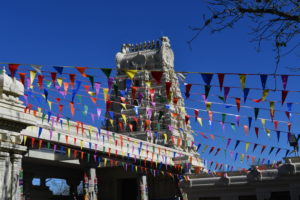
When filling out your travel plans for the new year, remember to save time to explore the areas right around you. Some people call them “staycations” or being a “hometown tourist.” The thing is that we often don’t make time to see some of the most interesting sites near our homes – those that might even top the “to see” list of a visitor – because we think we’ll get around to it sometime.
Guess what? “Some time” can be now!
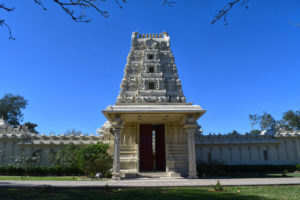
One of the features of Texas that makes it fascinating to explore is that it’s home to a diversity of cultures as big as the state. Yesterday I took the time to revisit the stunning Sri Meenakshi Temple in Pearland. Luckily for me, it was still bearing many of the colorful decorations of the celebration of the new year.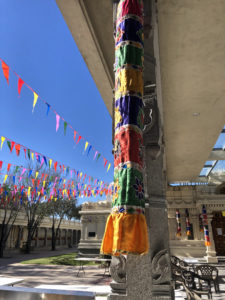
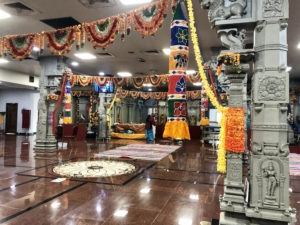
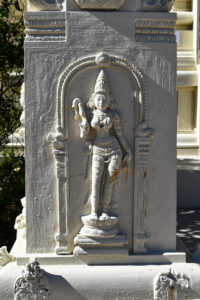 This is the only temple outside of India dedicated to Meenakshi, who is the Hindu Goddess of Marriage. It’s an exact replica of a temple in Madurai, India, with four smaller corner temples surrounding the main temple.
This is the only temple outside of India dedicated to Meenakshi, who is the Hindu Goddess of Marriage. It’s an exact replica of a temple in Madurai, India, with four smaller corner temples surrounding the main temple.
 The concrete structures were produced locally, but all of the granite stonework was carved and imported from India. They are currently having additional pillars carved there to add to the complex.
The concrete structures were produced locally, but all of the granite stonework was carved and imported from India. They are currently having additional pillars carved there to add to the complex.
When visiting, please keep in mind that this is a place of worship. Though they welcome visitors throughout the year, they request that appropriate clothing should be worn as a sign of respect, covering shoulders and knees. Shoes must be removed before going into the temple, but socks are allowed. Wooden shelves at the side entrances can also be used for their temporary storage, or you may leave your shoes on the ground outside of the temple and retrieve them as you leave.
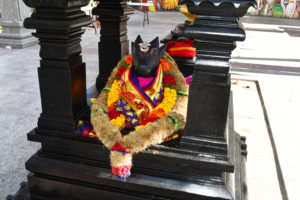
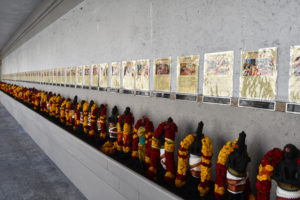 As you enter the large temple through the main doors, move around the interior in a clockwise motion. This signifies keeping “the god” on “the right.” Inside are four shrines dedicated to Shiva, Meenakshi, Vishnu and Lakshmi. In Hinduism there is a “pantheon of gods,” symbolizing many concepts and Hindus pray to them as their favorite or personal dieties.
As you enter the large temple through the main doors, move around the interior in a clockwise motion. This signifies keeping “the god” on “the right.” Inside are four shrines dedicated to Shiva, Meenakshi, Vishnu and Lakshmi. In Hinduism there is a “pantheon of gods,” symbolizing many concepts and Hindus pray to them as their favorite or personal dieties.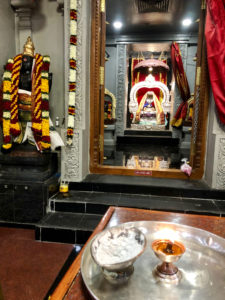
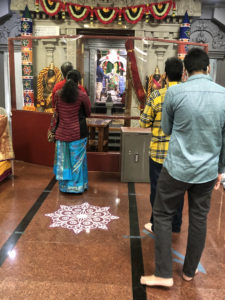 Photography is permitted, but as with any place of worship, please try not to be intrusive of those who are there to pray.
Photography is permitted, but as with any place of worship, please try not to be intrusive of those who are there to pray.
 After visiting the temples and taking in the remarkable architecture, follow one of the sidewalks behind the temple complex to the Peacock Sanctuary. The Indian Peafowl is the national bird of India, and the beautiful specimens that live here wander around an enclosure that can be viewed from benches surrounding it. My grandmother used to have peacocks and (although they can be obnoxiously loud early in the morning!) they always hold a place in my heart.
After visiting the temples and taking in the remarkable architecture, follow one of the sidewalks behind the temple complex to the Peacock Sanctuary. The Indian Peafowl is the national bird of India, and the beautiful specimens that live here wander around an enclosure that can be viewed from benches surrounding it. My grandmother used to have peacocks and (although they can be obnoxiously loud early in the morning!) they always hold a place in my heart.
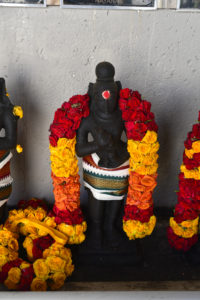 A Visitors Center is open from 8 a.m. to 8 p.m. on weekends, and if you are interested in learning more about the culture this is the time to visit. There is also an on site cafeteria that’s open to the public on weekends and serves authentic vegetarian fare. Visitors can purchase tokens and use them to pay for their meals.
A Visitors Center is open from 8 a.m. to 8 p.m. on weekends, and if you are interested in learning more about the culture this is the time to visit. There is also an on site cafeteria that’s open to the public on weekends and serves authentic vegetarian fare. Visitors can purchase tokens and use them to pay for their meals.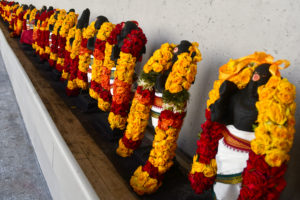
Several years ago, I took my young Girl Scout troop, and one of the temple priests invited them to sit on a rug with him while he explained some of the things they were seeing and hearing. What a wonderful experience!

Remember that although it may feel a bit awkward to step into an unfamiliar setting, as long as you are respectful of the people and culture the space serves, they openly welcome visitors.
Check the Temple’s Facebook page for the latest updates on visiting days and hours.
What are some of the places in your hometown that you’ve never taken the time to see for yourself?

Stone emojis? Well, kind of! These faces silently tell the story of an unrequited love in Ellis County long ago.
The courthouse itself is exquisite. This 1897 Romanesque Revival stunner was designed by architect J. Riely Gordon. If you’re a fan of Texas courthouses, you’ve heard his name before, since he designed 18 of them! But this one is undisputedly his masterpiece.
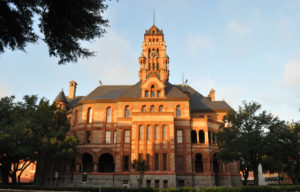
I promise to tell you more about this beauty another time, but for now we’re just going to talk about those faces! If you feel as if someone is watching you as your walk around the grounds of the courthouse square, you’re probably right.
MABEL’S FABLE
The story goes that sculptor Harry Herley arrived in Waxahachie in 1895 to work on carvings for the courthouse project during it’s construction. The itinerant English artist moved into Mama Frame’s boarding house, where he met and fell in love with her beautiful 16-year-old daughter Mabel.
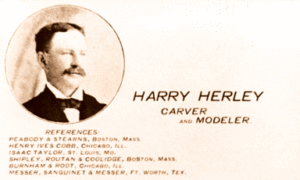
As his work continued on the courthouse, Harry’s love for Mabel grew, and he carved her angelic countenance to top the exterior columns of the courthouse.
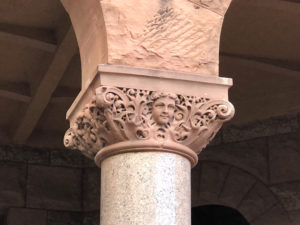
But, as fate would have it, the love was unrequite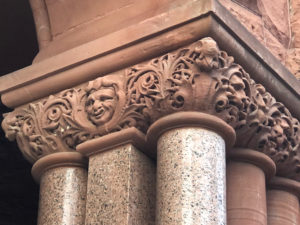 d and Mabel discouraged his constant attentions. As it became apparent to Harry that his love wasn’t returned, his disappointment slowly turned into bitterness, and the faces he carved to represent Mabel progressed from beautiful to grotesque and twisted. A lasting revenge for his broken heart.
d and Mabel discouraged his constant attentions. As it became apparent to Harry that his love wasn’t returned, his disappointment slowly turned into bitterness, and the faces he carved to represent Mabel progressed from beautiful to grotesque and twisted. A lasting revenge for his broken heart.
The townspeople weren’t too happy about the unattractive faces on the courthouse they had spend so much money to build, and one story relates that the cattlemen and farmers even tarred and feathered poor ol’ Harry and ran him out of town on a rail.
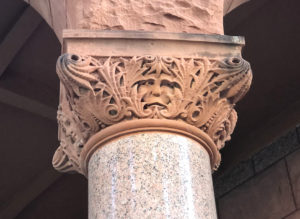
It’s a sad, but terrific tale ripe for retelling through the generations.
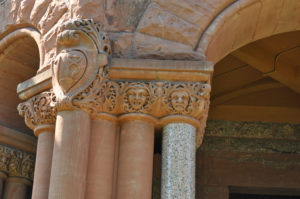
Spoiler alert: If you’re charmed by the legend and would prefer
to leave it at that . . .you might want to stop reading this now.
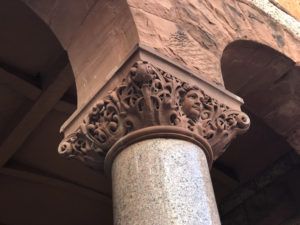
THE TRUTH
Mabel’s mother Hattie, although a widow, didn’t seem to be running a boarding house according to the federal census. Even if she had been, the chances are that Herley never met the Frame family.
The biggest obstacle to this story were the characters were when it was supposedly taking place.

The stone sculptures for the courthouse were sub-contracted to the Dallas firm of German stonemason Theodore Beilharz. Hervey, who worked for the company at the time, is created with carving the exquisite red sandstone capitals perched atop the polished pink granite columns, but he also supervised other carvers who worked on the project.
The carvings would have been created in the Beilharz’s Pacific and Hawkins Stoneyard in Dallas and shipped to Waxahachie by rail as finished pieces, ready to mount in place.
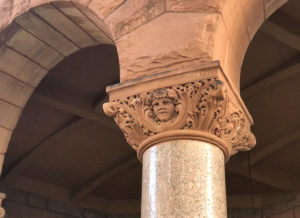 So…if Hervey wasn’t actually in Waxahachie, he certainly wasn’t occupied falling in love with one of its residents.
So…if Hervey wasn’t actually in Waxahachie, he certainly wasn’t occupied falling in love with one of its residents.
There’s no record of Hervey coming to town until the summer of 1896, a year after his work for the courthouse was completed, to work on another stone carving assignment for a prominent businessman.
It was on this trip that he met local girl Minnie Hodges, whom he married in August of that year.
Many of Reilly’s courthouses feature faces and gargoyles, appropriate for the Romanesque style, and its likely that the design or at least the theme for the faces was under his direction. Unfortunately no records show what the intended meaning of the progression was meant to represent…which opens them up to storytelling.
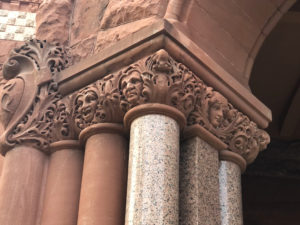
It’s still a good story, and I bet if we checked back in a hundred years..it will still be told.
Most local lore has elements of truth woven into it. Does knowing the true stories “ruin it” for you, or make it more interesting?
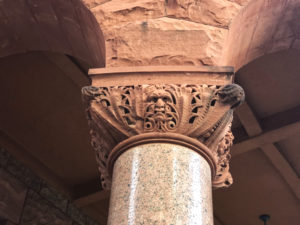
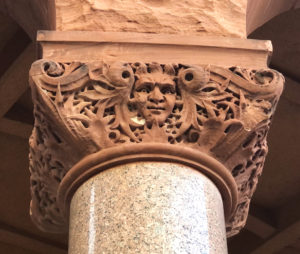
And what’s a Texas legend without a song to go along with it? To listen to Jeremiah Richey’s ditty about the Eliis County Courthouse faces, click here.
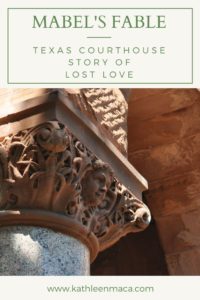


 This is the only temple outside of India dedicated to Meenakshi, who is the Hindu Goddess of Marriage. It’s an exact replica of a temple in Madurai, India, with four smaller corner temples surrounding the main temple.
This is the only temple outside of India dedicated to Meenakshi, who is the Hindu Goddess of Marriage. It’s an exact replica of a temple in Madurai, India, with four smaller corner temples surrounding the main temple. The concrete structures were produced locally, but all of the granite stonework was carved and imported from India. They are currently having additional pillars carved there to add to the complex.
The concrete structures were produced locally, but all of the granite stonework was carved and imported from India. They are currently having additional pillars carved there to add to the complex. As you enter the large temple through the main doors, move around the interior in a clockwise motion. This signifies keeping “the god” on “the right.” Inside are four shrines dedicated to Shiva, Meenakshi, Vishnu and Lakshmi. In Hinduism there is a “pantheon of gods,” symbolizing many concepts and Hindus pray to them as their favorite or personal dieties.
As you enter the large temple through the main doors, move around the interior in a clockwise motion. This signifies keeping “the god” on “the right.” Inside are four shrines dedicated to Shiva, Meenakshi, Vishnu and Lakshmi. In Hinduism there is a “pantheon of gods,” symbolizing many concepts and Hindus pray to them as their favorite or personal dieties.






















